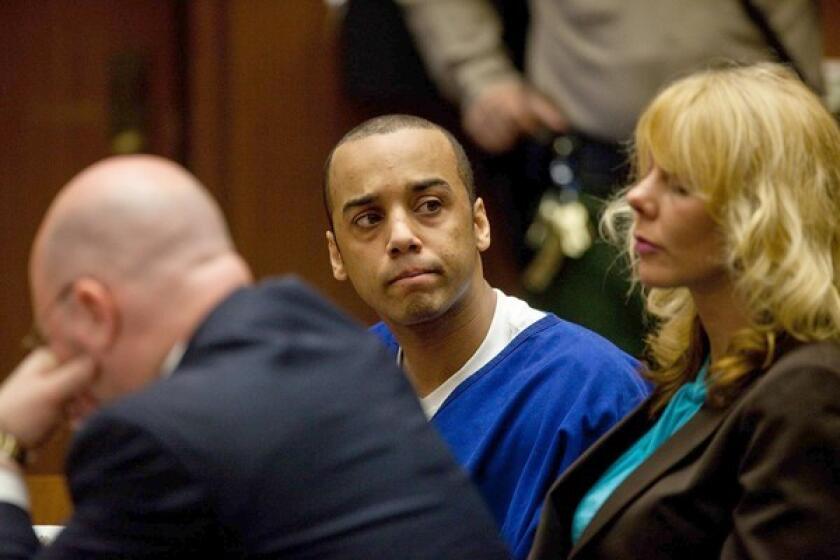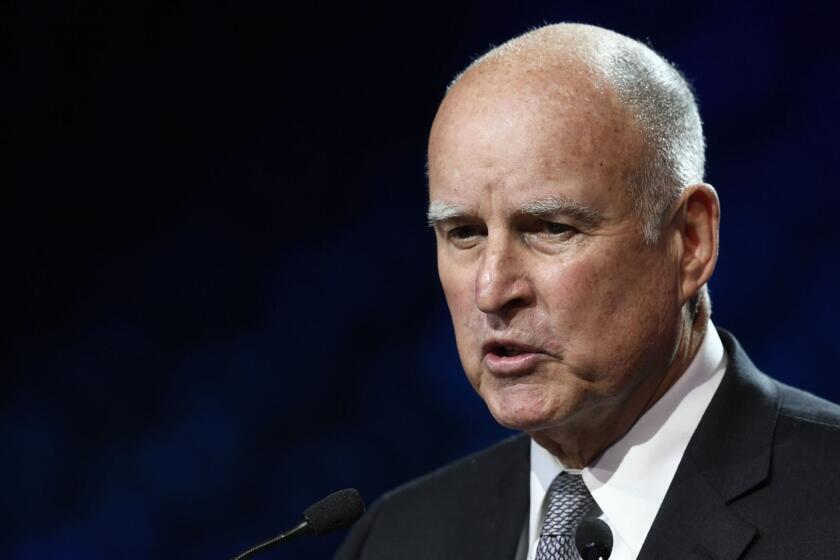(Jess Hutchison / Los Angeles Times)
- Share via
When Mary Reese received a call at the California Institution for Women in 2021, a prison official told her she had “won the lotto.”
Gov. Gavin Newsom had granted her mercy with a commutation shortening her sentence of 35 years to life for a series of burglaries committed in 2007. She believed she’d be free and reunited with her family within days.
But a year and eight months after Newsom noted her “good prospects for successful community reentry,” Reese, 64, remains in prison.
While the governor’s clemency power allows him to unilaterally free people he deems worthy, most of the time he doesn’t use it that way. Instead, he sends prisoners to the parole board, allowing its commissioners — who include attorneys, former wardens and correctional officers — to decide their fate.
Newsom has granted 123 commutations, or reductions of sentences, since he became governor in 2019. But as of January, a third of those people remained behind bars — in some cases years after the governor’s recommendations, according to data from the California Department of Corrections and Rehabilitation. That’s due largely to Newsom’s decision to defer to the parole board in the vast majority of his commutations.
The board denied Reese release six months after Newsom announced her commutation. Among the reasons: She had violated prison rules by stealing some fabric thread and borrowing a hair straightener to use for church in prison on Sundays, according to a transcript of her suitability hearing obtained by The Times.
The board’s decision came after Newsom praised her in his commutation for her use of self-help programs, an “exemplary discipline record” and “sincere remorse.”
Deputy Commissioner Rosalio Castro told Reese at the hearing that there are “no small rules” for a “lifer” like her. That includes rules prohibiting loaning or sharing personal property.
“I never hurt anyone ever in my life. I don’t understand why I didn’t get this,” Reese said in a phone call from prison in January.
“Who is [Newsom] giving mercy to, then?”

The governor’s approach is consistent with the clemency process used by his predecessor, Gov. Jerry Brown, who was both heralded and criticized for setting records with his acts of mercy and allowing people originally sentenced to life without the possibility of parole a chance at freedom.
Representatives for both governors said they have aimed to balance clemency with concerns about public safety. But deference to the parole board has further complicated a byzantine system in which people can remain imprisoned long after even the governor praises their rehabilitation.
Newsom, a liberal icon who issued a moratorium on the death penalty during his first year in office and has ordered the closure of some state prisons, has touted his clemency power as “an important part of the criminal justice system” in news releases announcing his commutations.
In addition to the 123 commutations, which shorten sentences for those currently in prison, Newsom has issued 140 pardons — which restore some rights after release — and 35 medical reprieves for people facing health risks.
Nineteen people who have received a commutation from Newsom have been denied release by the parole board, according to state prison officials. Another 11 who have received commutations have been granted parole by the board but remain in prison still awaiting release.
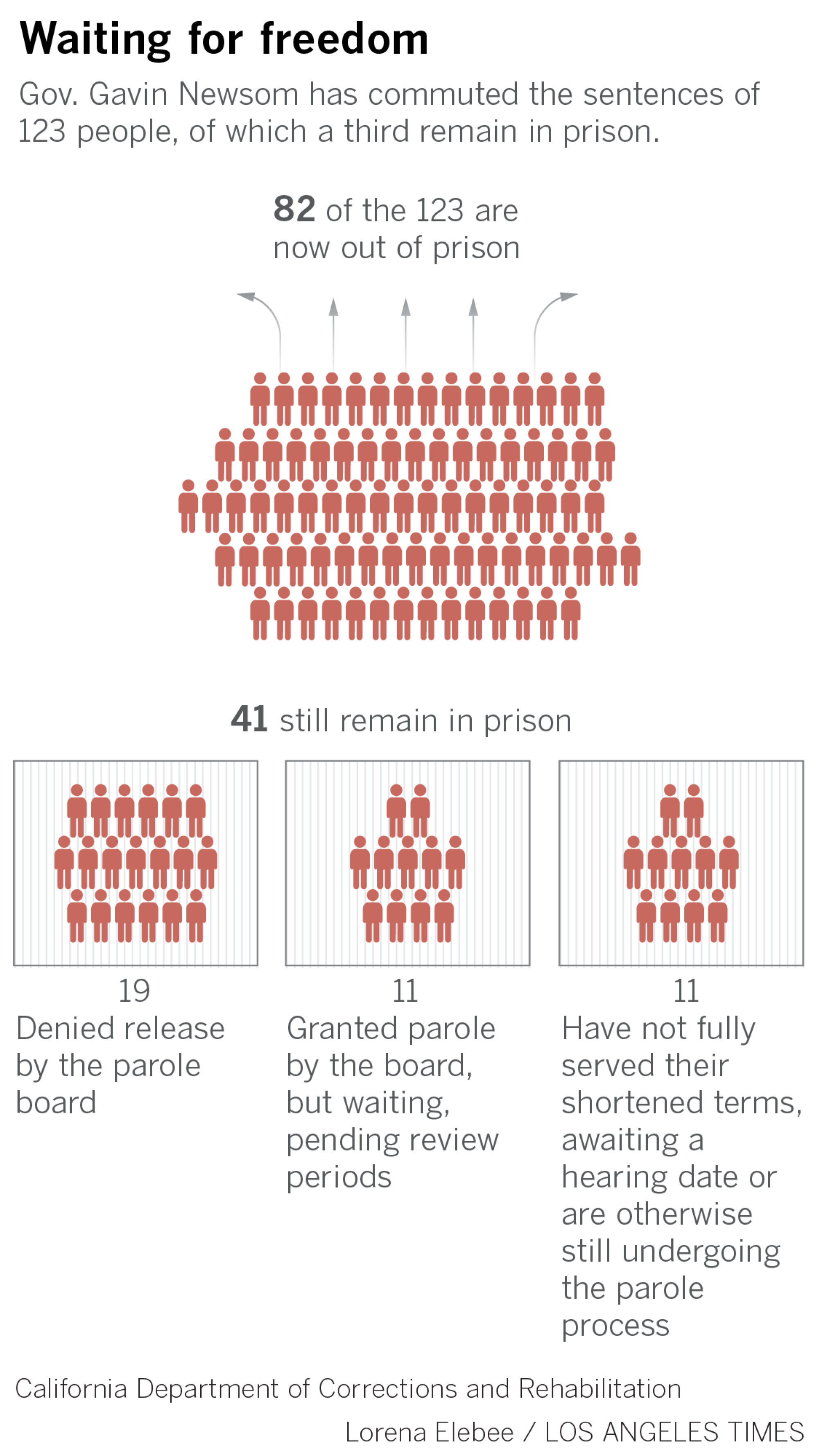
Altogether, 41 people whose sentences Newsom has commuted remain in prison, including 11 who have either not yet fully served their shortened sentence terms, are awaiting parole hearings or are elsewhere in the process. (In two of those cases, people have voluntarily waived a previously scheduled hearing.)
Prison rights advocates and criminal defense attorneys say putting the onus on the parole board, known for its selective and often lengthy process, undercuts the purpose of a governor’s clemency power.
“Clemency is meant to be an extraordinary measure, and it’s guaranteed in the California Constitution. It’s meant to bring attention to individuals who committed serious crimes but have transformed their lives in prison and have been punished enough,” said Katie Tinto, director of the Criminal Justice Clinic at the UC Irvine School of Law.
Federal commutations granted by U.S. presidents are more efficient than California’s, Tinto said, calling the current dependence on the parole board “problematic” and “outrageous.”
“The idea that they can make it to that level, where the governor has recognized their efforts and rehabilitation, and then the parole board says that they have to remain behind bars, it is completely at odds with each other,” she said.

Dana Williamson, Newsom’s chief of staff, said the governor’s commutation model “is exactly right” and creates a necessary balance between mercy and public safety.
She said that parole board leadership is best equipped to make judgments in clemency cases, as their “robust process” includes risk assessments, tracking of patterns and input from forensic psychologists.
Williamson, who also was a top aide to Brown, said one wrong commutation decision could set back years of progress California has made on criminal justice reform. She recalled sitting in the room with both governors as they pored over clemency applications.
“The entire premise of all of these reforms was to give people a chance and hope to get out of prison and to go live their lives, but it was with strong rehabilitative measures and accountability and balancing public safety and utilizing experts,” Williamson said.
Multiple layers of scrutiny are built into California’s clemency system. The parole board is heavily involved in the process, voting on and recommending cases to the governor for his consideration. The state Supreme Court is also required to sign off on clemency applicants who have been convicted of more than one felony.
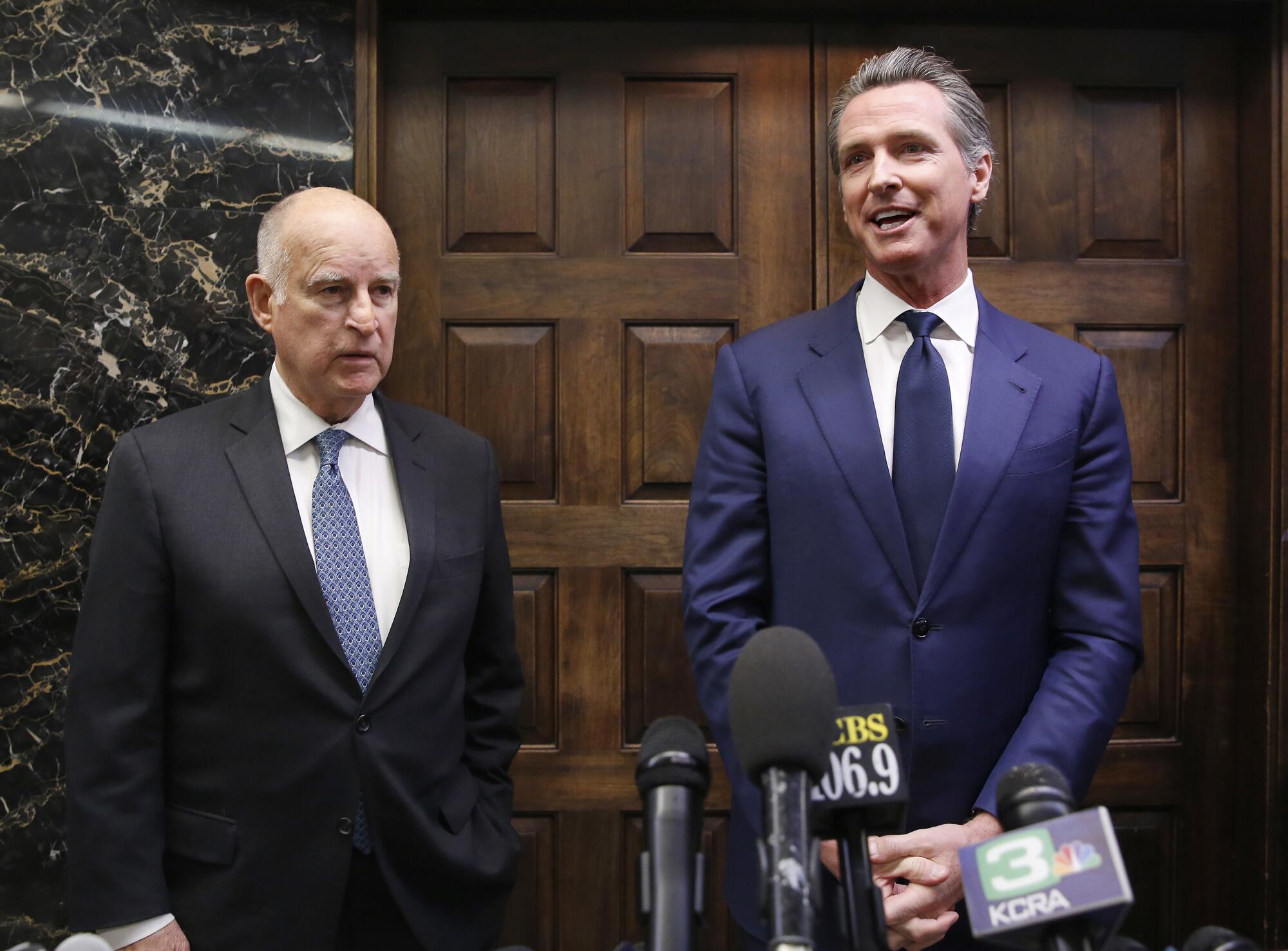
In the case of Reese, Newsom acknowledged in his announcement that both the Board of Parole Hearings and the California Supreme Court had recommended her for clemency prior to his review. Still, she was denied release at a later parole suitability hearing.
Giving the parole board the final say can essentially render commutation meaningless in some cases, said Mark Osler, a law professor at the University of St. Thomas and co-founder of the Clemency Resource Center at New York University.
“That doesn’t seem to add any value. It’s not like the board doesn’t already have input. Giving them a veto at the back end ... it’s hard to see it as anything other than political cover,” Osler said. “It’s so strange that in granting mercy, we see such timidity.”
In some instances, Newsom — a Democrat who is consistently suggested as a presidential nominee — has freed people directly without involving the parole board. In 2021, he commuted the sentence of Teresa Paulinkonis, who spent 31 years in prison for murdering her stepfather, who she said sexually abused her. In her commutation, Newsom did not defer to the parole board but simply said Paulinkonis was “ready to be released on parole.” She is no longer in prison.
He also directly commuted the sentence of Swedish musician David Jassy in 2020, who was convicted of second-degree murder after, in a fit of road rage, he punched and kicked a pedestrian before running him over with his SUV, according to court testimony. Jassy unintentionally struck the man with his car while he was leaving, according to clemency documents.
His case garnered the attention of Kim Kardashian in part because of his behavior in San Quentin State Prison, where he mentored young prisoners through a rap music program. Jassy was deported to Sweden after being released from prison.
Reality show star Kim Kardashian West, who has embraced prison reform as a pet cause, praised Newsom’s action on twitter.
Cristina Chavez‘s commutation, however, was sent to the parole board by Newsom. She was 21 in 2008 when she acted as a driver for someone who burglarized a vehicle, according to clemency documents. She shot at the car owner’s brother with a BB gun, but missed. Later that year, she was tried for another crime, in which a man waiting in his car in a fast-food drive-through was shot and injured by a woman using a real gun.
Chavez denied the latter crime and said she was wrongly convicted. She was sentenced to 34 years and eight months to life for burglary and vandalism charges she has admitted to, and an attempted murder charge for the shooting that she maintains she did not commit.
In his commutation of her sentence in 2019, Newsom wrote that Chavez has been described as “kind, even-tempered, hardworking” and honest.
She was denied parole twice after Newsom’s commutation. Prison records show that her next tentative date for a parole suitability hearing is in June.
Chavez, now 36, is afraid that the parole board has denied her because she won’t admit to one of the crimes for which she’s been convicted. She said she’s been studying her “character defects” in preparation for her next hearing but is confused about what parole board commissioners are looking for.
In her last hearing, in September 2021, Chavez pointed to being molested at 8 years old, and witnessing domestic violence, as contributing to an addiction that led to crime. She seemed to struggle with some questions asked by commissioners, saying that she could not remember details of her past and asking them to repeat themselves or to take a moment to collect her thoughts, according to a transcript obtained by The Times.
When she maintained her innocence regarding the attempted murder charge, presiding commissioner Kevin Chappell asked: “So if you didn’t commit the crime, why are you sitting in prison today?”
(Jess Hutchison/Los Angeles Times)
Chavez, who has asked herself that same question many times, felt stuck: She said she deserved to be there for her other mistakes.
Ultimately, the board declared her unsuitable for parole, citing a lack of self control, “immature thinking” and accusing her of not taking full responsibility for her actions.
“The governor obviously saw something in me to say, ‘That person deserves a commutation out of thousands of people in prison.’ I have broken the cycle of violence in my life. I know I’m not a violent person, and I’m not a threat,” Chavez said in a phone interview from the California Institution for Women in Chino. “My God, I wish they would see that.”
Reese, who was also denied parole after receiving a commutation from Newsom, said she felt “mistreated” by the parole board and that “they had no intention of letting me go.”
Reese’s sentence included enhancements under California’s “three strikes” law, which was approved by voters in 1994. Her crimes included credit card data theft, vehicle theft and theft from an elderly person.
During her hearing, she pointed to being raped at 13, and giving birth at 14, as well as the gang-related murder of her son, as reasons for her poverty and addiction that led her to crime.
Still, parole board commissioners said she demonstrated “lack of change” after serving more than 13 years in prison and posed “an unreasonable risk to public safety.”
She wonders why Newsom sent her to the parole board in the first place.
“I was speechless. I didn’t want to act as if I wasn’t grateful, but having to go to the board caught me totally off guard. I wasn’t prepared for that,” she said about the moment she realized the governor’s interference in her case wasn’t what she thought.
Reese is eligible for parole in November 2025, according to state prison records.

In a report published in January, the nonpartisan Legislative Analyst’s Office warned that California’s parole board has “overly broad discretion” that could lead to inequitable outcomes and “biased decisions.” The analyst recommended that the Legislature consider limiting the board’s power and improving transparency and oversight.
Board of Parole Hearings Executive Officer Jennifer Shaffer said the process analyzes someone’s individualized “criminality” and possibility of re-offending while also offering people hope. In most cases, Newsom is not ordering the board to do anything, she said, but to hear a case.
“People now have a meaningful opportunity for release. The power of that hope has changed people, it has motivated people to rehabilitate,” she said.
When asked why people like Reese and Chavez have been denied parole but people like Richard Fuentes Revelez, who sexually abused and impregnated an 11-year-old girl, was granted parole in December, Shaffer said they are held to the same standards.
Newsom aides said not all of the information that the governor and the parole board use to make decisions about parole cases is made public.
“A lot of people look at this and go, ‘Well, why is this person being denied even though their crime was far less egregious than this other person’s crime?’ But you really have to look at who the person is today. And in every single case, what we’re looking at is what were the criminogenic factors that lead to their criminality?” Shaffer said. “We try to be as consistent in our decision making as possible.”
Revelez remains in prison, according to state records.
Critics of the parole process say treating it like a science is dangerous and can remove the human element. Prisoners say they study for an appearance before the parole board as if it is a test that is hard to pass.
Parole hearings are thorough and can be traumatic, said Milena Blake, an attorney for the Three Strikes Project at Stanford Law School. Judgments are inconsistent and can depend on a person’s public speaking skills instead of their rehabilitation or innocence, or a commissioner’s own biases, she said.
While Blake praised Newsom for some of his progressive criminal justice policies, she said it is “certainly well within his authority” to commute sentences without involving the parole board, calling his approach “politically convenient.”
Blake represented Reese during her suitability hearing and said she was “flabbergasted” by the parole board’s focus on what she viewed as mild infractions in prison and crimes she committed as a teenager.
“Many people have gone into those rooms and have been required to think about the worst things they’ve ever done and ever had done to them in order to get a chance at freedom,” Blake said. “Do I wish there would be more outright releases? Yes. All we can do is keep pushing to get the people who really would be completely safe to release, and would actually be an asset to their communities, more opportunities to do that.”

Proponents of clemency point to research that shows people “age out” of crime and also to the cost to taxpayers to keep people imprisoned: an average of $106,000 a year per prisoner, according to the LAO. Commuting sentences is also one way the state’s facilities have tried to reduce overcrowding.
But there are critics who say California’s Democratic leaders are too lenient on people who have committed crimes.
When Newsom commuted the sentence of Steven Bradley in 2020, Kern County Dist. Atty. Cynthia Zimmer slammed the governor for allowing his release despite her objections.
The commutation “glosses over” Bradley’s murder of a gas station attendant during a robbery, Zimmer said in a news release urging the victim’s family members to participate in the parole process. She called Newsom’s order a “drastically misguided effort” and questioned how he had “found time” during the COVID-19 pandemic to prioritize commutations.
Bradley was granted parole in January. He remains in prison, according to state records.
Greg Totten, chief executive officer for the California District Attorneys Assn., said prosecutors have concerns that commutations and early release are overused.
“There are some offenders that are so prolifically dangerous to the public that they need to be incapacitated through incarceration, and sadly a number of those people are being released early and victims are being surprised by that and endangered by it,” he said.
Newsom has also used his powers to reverse decisions made by the parole board and keep people in prison if he feels that they still pose a risk to society. He reversed the parole board’s decision to release Sirhan Sirhan in 2022, saying his 1968 assassination of Sen. Robert F. Kennedy “changed the course of this nation.”
In each commutation he has granted, Newsom says that his act of clemency “does not minimize or forgive” someone’s conduct or the harm it caused but recognizes the rehabilitation they’ve done in prison.
The infamous case of Willie Horton, who raped a woman and assaulted her boyfriend after being allowed to leave a Massachusetts prison in 1987, has put politicians on alert for decades. The case, which was used by Republican George H.W. Bush to defeat Democrat Michael Dukakis for president, has become a symbol of “tough on crime” policy standards.
Williamson, Newsom’s aide, acknowledged the potential for political backlash and said using clemency as often as he does is a testament to the governor’s belief in changing the criminal justice system.
“The last thing anybody wants is to make a decision like this and be wrong,” she said.
Involving the state parole board in clemency decisions is not unique to the Newsom administration.
Brown granted 283 commutations from 2011 to 2019, nearly double the number issued by the preceding nine governors combined. Brown’s predecessor Arnold Schwarzenegger, a Republican, granted 10 commutations, and before him, Gray Davis, a Democrat, issued none.
But, like Newsom, in an overwhelming majority of those cases, Brown allowed the parole board to have the final say.
Brown spokesperson Evan Westrup said state history is crucial to understanding why California’s clemency process is what it is today. He defended what he called “an extra layer of review” by the parole board and said caution was necessary in order to achieve Brown’s goal to establish a “regular, consistent” executive clemency process after acts of mercy had dwindled under previous administrations.
“The fact that this practice has continued under the current administration is testament to the prudence of that approach,” Westrup said. “One mistake could blow up the entire process and practice, which we so painstakingly restored, and lead to a return to the days when commutations simply aren’t granted.”
But there’s a gap between the public understanding of Newsom’s commutations and what is actually happening in California’s state prisons, said Sen. Dave Cortese (D-San Jose.)
“A commutation should be what the word means: that the sentence is ended, and not dependent on a subsequent hearing years from now,” Cortese said. “The issue becomes: which one of them would have seen their grandchild born? Which one of them would have attended a Little League game but for the fact that someone can’t get around to granting them release?”

Even for those who are granted parole, release is not immediate. There is a review period of up to 120 days following a parole board hearing, which allows decisions to be overseen by the board’s legal team before they are finalized. Parole decisions that become final are then subject to review by the governor, who has 30 days to make a decision.
Aides for Newsom said that the process takes time because of potentially serious consequences, and that the state would need to hire more legal staff to keep up with the ever-increasing number of people up for parole, in thanks part to sentence-reform laws that have made more people eligible.
The governor has reviewed about 5,000 parole cases since taking office, according to Williamson.
In the case of Rahsaan Thomas, co-host of the Pulitzer Prize-nominated “Ear Hustle” podcast, it took more than a year for him to be released from San Quentin State Prison after receiving a commutation from the governor.
Thomas, 52, was sentenced to 55 years and six months to life for a second-degree murder conviction and other charges after he fatally shot someone and injured another during a drug deal in 2000, according to clemency documents.
Rahsaan ‘New York’ Thomas has drawn acclaim for his contributions to the San Quentin News and for his work on the podcast ‘Ear Hustle.’
In his commutation in January 2022, Newsom praised Thomas for completing college courses and an array of programming, saying he has “dedicated himself to his rehabilitation.”
Thomas received dozens of recommendations urging Newsom and the parole board to consider him for commutation, which he initially applied for in 2017 under the Brown administration.
In an interview with The Times in early January, Thomas said he is thankful to both the governor and the parole board, saying the process helped him to heal and reflect on his past. But he was struggling to plan for the future and explain to his family the uncertain timing for his release. His family did not deserve “the agony of all the false hope and hurdles,” over the past year, he said.
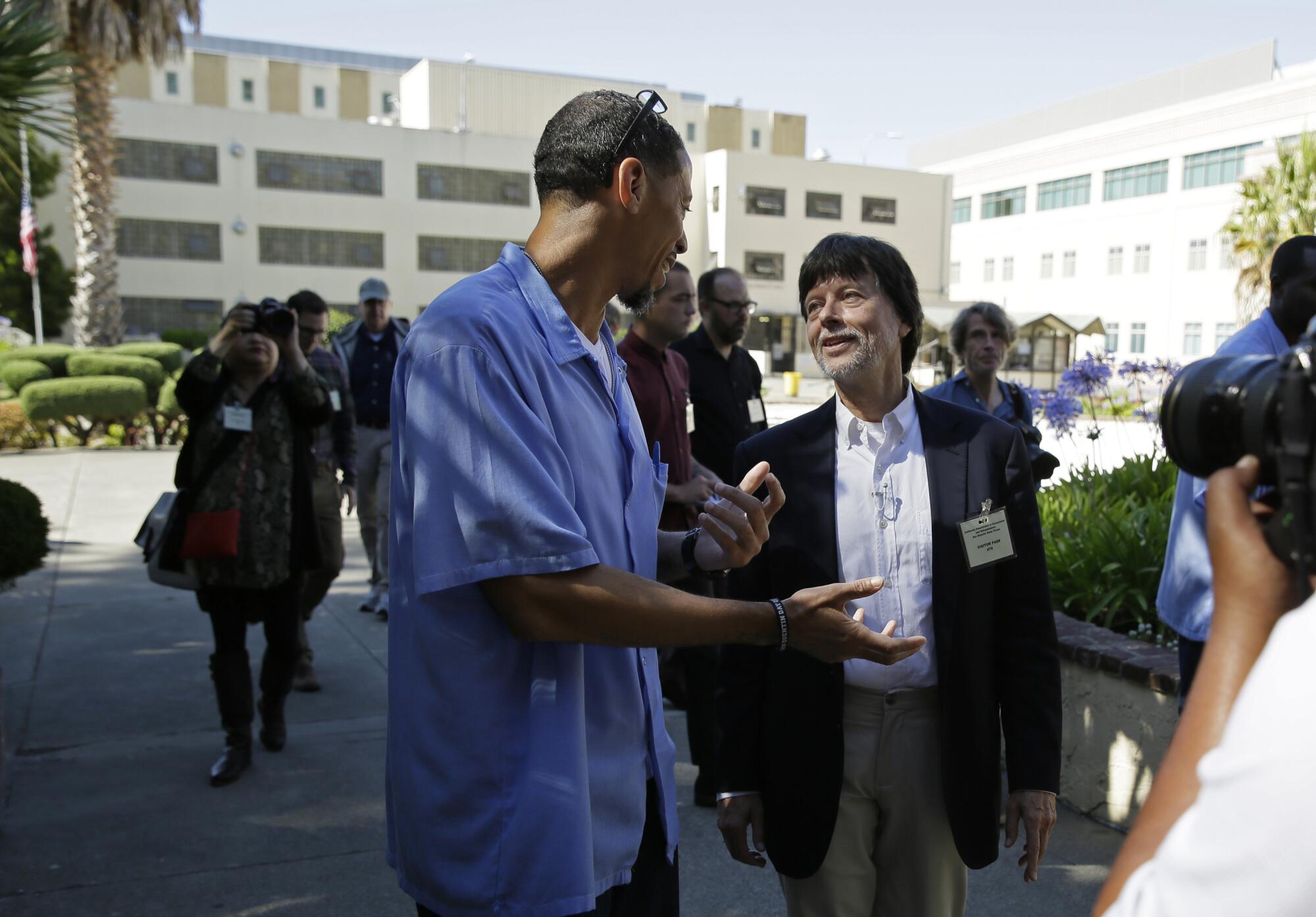
“I can’t curse a blessing,” Thomas said from prison Jan. 11. “My one wish is that this process, if you get a commutation, it should be streamlined. Really, it should be streamlined for everybody. ... If you decided it’s safe to let me go, why drag it out?”
He said he knows that he is one of the lucky ones, calling his friends who have failed to get past the parole board “invisible.” Still, time is precious. “Every day matters,” he said.
Thomas was released from prison on Wednesday, just hours after his case was mentioned in a story published by The Times, to the celebration of an array of supporters he has garnered over the years through his journalism about prison life.
More to Read
Sign up for Essential California
The most important California stories and recommendations in your inbox every morning.
You may occasionally receive promotional content from the Los Angeles Times.

